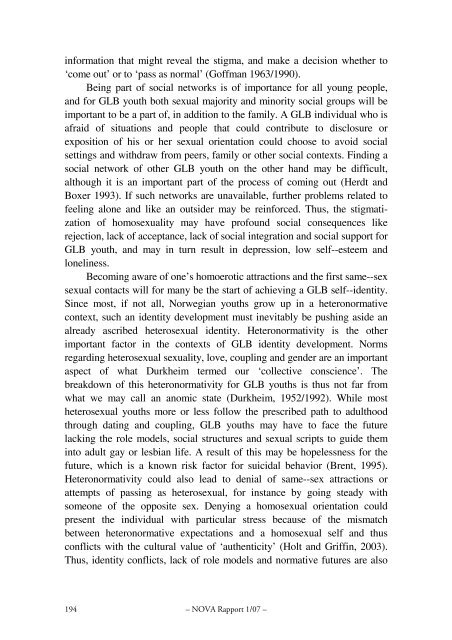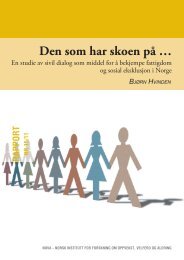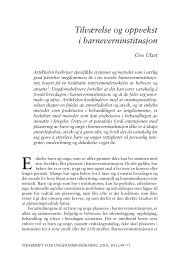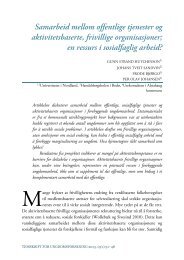Betydningen av seksuell erfaring, tiltrekning og identitet for ...
Betydningen av seksuell erfaring, tiltrekning og identitet for ...
Betydningen av seksuell erfaring, tiltrekning og identitet for ...
Create successful ePaper yourself
Turn your PDF publications into a flip-book with our unique Google optimized e-Paper software.
in<strong>for</strong>mation that might reveal the stigma, and make a decision whether to<br />
‘come out’ or to ‘pass as normal’ (Goffman 1963/1990).<br />
Being part of social networks is of importance <strong>for</strong> all young people,<br />
and <strong>for</strong> GLB youth both sexual majority and minority social groups will be<br />
important to be a part of, in addition to the family. A GLB individual who is<br />
afraid of situations and people that could contribute to disclosure or<br />
exposition of his or her sexual orientation could choose to <strong>av</strong>oid social<br />
settings and withdraw from peers, family or other social contexts. Finding a<br />
social network of other GLB youth on the other hand may be difficult,<br />
although it is an important part of the process of coming out (Herdt and<br />
Boxer 1993). If such networks are un<strong>av</strong>ailable, further problems related to<br />
feeling alone and like an outsider may be rein<strong>for</strong>ced. Thus, the stigmatization<br />
of homosexuality may h<strong>av</strong>e profound social consequences like<br />
rejection, lack of acceptance, lack of social integration and social support <strong>for</strong><br />
GLB youth, and may in turn result in depression, low self--esteem and<br />
loneliness.<br />
Becoming aware of one’s homoerotic attractions and the first same--sex<br />
sexual contacts will <strong>for</strong> many be the start of achieving a GLB self--identity.<br />
Since most, if not all, Norwegian youths grow up in a heteronormative<br />
context, such an identity development must inevitably be pushing aside an<br />
already ascribed heterosexual identity. Heteronormativity is the other<br />
important factor in the contexts of GLB identity development. Norms<br />
regarding heterosexual sexuality, love, coupling and gender are an important<br />
aspect of what Durkheim termed our ‘collective conscience’. The<br />
breakdown of this heteronormativity <strong>for</strong> GLB youths is thus not far from<br />
what we may call an anomic state (Durkheim, 1952/1992). While most<br />
heterosexual youths more or less follow the prescribed path to adulthood<br />
through dating and coupling, GLB youths may h<strong>av</strong>e to face the future<br />
lacking the role models, social structures and sexual scripts to guide them<br />
into adult gay or lesbian life. A result of this may be hopelessness <strong>for</strong> the<br />
future, which is a known risk factor <strong>for</strong> suicidal beh<strong>av</strong>ior (Brent, 1995).<br />
Heteronormativity could also lead to denial of same--sex attractions or<br />
attempts of passing as heterosexual, <strong>for</strong> instance by going steady with<br />
someone of the opposite sex. Denying a homosexual orientation could<br />
present the individual with particular stress because of the mismatch<br />
between heteronormative expectations and a homosexual self and thus<br />
conflicts with the cultural value of ‘authenticity’ (Holt and Griffin, 2003).<br />
Thus, identity conflicts, lack of role models and normative futures are also<br />
194<br />
– NOVA Rapport 1/07 –

















